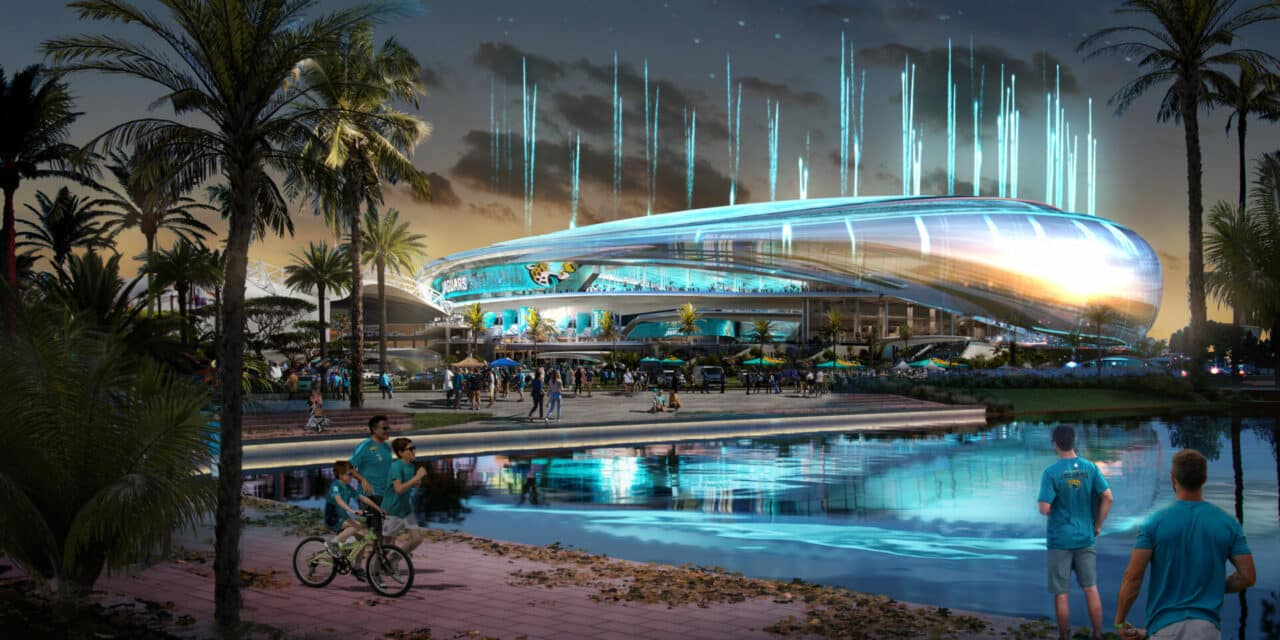JAGS JOURNEY: Architectural renderings show the next generation of TIAA Bank Field, under a proposal to reconstruct the stadium, home of the NFL Jacksonville Jaguars. (Courtesy HOK)
A total makeover of TIAA Bank Field with a roof canopy is projected to cost between $1.3 billion to $1.4 billion, hiked by inflation, said Mark Lamping, president of the Jacksonville Jaguars, the stadium’s primary tenant.
On Wednesday, Lamping gave an update on the project after the Jaguars, in tandem with HOK, their architect, released a new sizzle video and fresh renderings of the proposed renovation of a building whose infrastructure dates to 1928.
As VenuesNow reported in December, the Jaguars decided to renovate TIAA Field over building a new stadium after spending the past three years studying the issue with architects and two general contractors, AECOM Hunt and Barton Malow, both providing pre-construction services.
Project officials felt it would be much less expensive to renovate. Six months later, price escalation pushed well beyond the $1 billion sources said were initial estimates for the “gut rehab,” as Lamping described for a largely reconstructed venue, using home improvement show jargon.
“As it relates to some commodities, we’re seeing a softening in prices, but not in all groups,” he said. “Crazy inflation in the construction industry can’t continue or else it’s going to shut everything down. But we’re pleased with the work from AECOM Hunt and Barton Malow.”
The Jaguars remain committed to upgrading the stadium with the vision of sharing equally the overall investment with the city of Jacksonville, which extends beyond renovating the facility to redeveloping spaces adjacent to the venue.
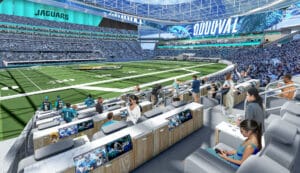
It’s a heavy lift for both parties, considering the overall scope could exceed $2 billion, including the area surrounding the stadium. The finance package hinges on the Jaguars signing a lease extension with the city, which owns the stadium.
The team’s current lease runs through the 2029 season, Lamping said.
For the Jaguars, the next step is conducting a series of 14 public meetings across Jacksonville over the next 10 days, which could lead to some design modifications. At that point, the Jaguars hope to engage in discussions with Donna Deegan, Jacksonville’s newly elected mayor, on how to move forward with the overall redevelopment.
Deegan, the city’s first female mayor and a former local television news anchor, officially takes over on July 1.
“She has expressed that the Jaguars are very important to Jacksonville, and our interests are aligned because Jacksonville is very important to the Jaguars,” Lamping said. “Starting with that premise, both parties are motivated to find a solution.”
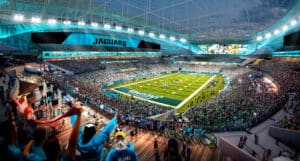
The deal for financing the renovation tied to a lease extension would require 75% approval among the NFL’s 32 team owners, reflective of the agreements in other small markets to build new stadiums for the Buffalo Bills and Tennessee Titans, Lamping said.
Both of those agreements include public money, running from $500 million in Nashville to $850 million in Buffalo.
“Quite honestly, that’s what’s needed in Jacksonville,” Lamping said. “We have aspirations to attract many other significant events such as the College Football Playoff championship game, for example. To win an event like that, you must have things for people to do before, during and after the event, plus places to stay, because the experience extends to well beyond what’s inside the stadium.”
The video and renderings show a striking roof canopy and a shiny reflective surface on the exterior. Those structures were formed in part by two types of ETFE, which is a clear plastic material used as enclosures at multiple NFL stadiums.
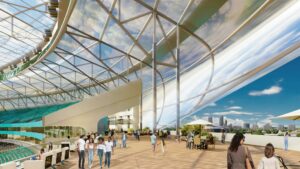
In Jacksonville, the exterior wall is a new high-tech, energy efficient ETFE composite, which operates “almost like sunglasses; reflective from the outside, but you can see through it from the inside,” Lamping said.
The new material is called ViewScape, and to this point, it has not been used for a sports project, said HOK’s Bill Johnson, a senior vice president and design principal at the firm. It’s a little bit thicker material and has a bigger span. The unique aspect of ViewScape is the ability to apply a reflective coating to the surface in multiple colors to reduce heat retention, Johnson said.
The application at TIAA Bank Field would help reduce heat retention by more than 70%, lowering temperatures by 10 to 15 degrees.
“We have (designed) mirror glass buildings all over the world; we’ve just never applied it in a way that’s trying to control temperature in sports venues,” he said. “The Jaguars’ biggest priority was fan comfort. They can never sell the east upper stands because there’s no shade, no overhead or anything to protect people.”
The top of the roof canopy membrane is made of the standard, fritted ETFE material that brings sunlight into other buildings such as US Bank Stadium, SoFi Stadium and Allegiant Stadium, with protection from weather elements.
TIAA Bank Field would remain an open-air venue in the end zones with natural ventilation by capturing the prevailing breezes off the nearby St. Johns River, Johnson said.

Other design highlights: a 360-degree main concourse four times wider than the current layout and elevated 30 feet above the ground, offering expansive views of downtown Jacksonville and the St. Johns River; 13 new elevators and 32 new escalators; 220 new food and drink points of sale; 14 new restrooms, and living room boxes, similar to the premium seat products at Hard Rock Stadium, another HOK renovation project.
“The big thing for the Jaguars is that the way the building is currently, you walk in at field level and go up the ramps to get to the main concourse,” Johnson said. “We’ve raised the entire entry level 30 feet to the main concourse by introducing berms and escalators. It gives you these amazing views of the river and the city and separates the service level functions, which right now is an operational nightmare for them.”
The massive videoboards in both end zones, some of the NFL’s biggest screens, would remain intact as part of the retrofit. Under the theme, “Horizon Board,” Johnson said, new LED ribbon boards on the back of the upper deck would “clip” to the existing boards and connect to the lower and upper concourses to create an immersive experience without hanging a halo board at midfield.
For the annual Florida-Georgia college football game, the schools flip sides in the seating bowl every year, depending on who’s the home team, so the screens would be programmable in that respect, Johnson said.
Outside TIAA Bank Field, fans would enter the building through a subtropical park, indicative of Florida, leading them to the main concourse. As reported in December, the seating bowl would be reduced to 62,000 with expansion to 71,500 for the annual Florida-Georgia game and concerts.
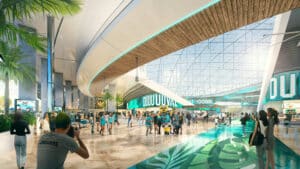
For the Jaguars, the best-case scenario, pending a deal with the city, would be to start construction after the 2025 season, with the team playing two years at a temporary location before returning to TIAA Bank Field for the 2028 season.
“The closest stadiums are in Gainesville and Orlando,” Lamping said, referencing the University of Florida’s Ben Hill Griffin Stadium and Camping World Stadium, owned by the city of Orlando.
“There could also be a temporary solution in Jacksonville, adding seats to the (city’s minor league) baseball stadium or the track stadium at the University of North Florida,” he said. “Both options come with a big (retrofit) of $125 million.”
One local report mentioned Daytona International Speedway as an option. The 101,500-capacity racetrack may seem far-fetched for NFL football, but Lamping didn’t dismiss the opportunity. He plans to meet with track officials over the next few weeks to discuss it.
“It would be an interesting solution, but would also require significant investment in terms of infrastructure,” Lamping said. “It can accommodate a big crowd. It would be a little wonky, but it’s worth considering. After the (Daytona Rising) renovations, it’s nice.”
He said, “I hope we have to deal with that issue (of temporary relocation) because that means we would have a stadium deal.”
Editor’s Note: This story has been updated.
